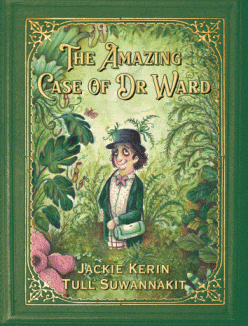
The Amazing Case of Dr Ward
The Amazing Case of Dr Ward
Jackie Kerin
Tull Suwannakit
Ford Street, 2021
32pp., pbk., RRP $A16.95
9781925804706
In the late 18th and early 19th centuries as more and more of the world was opened up by explorers like Captain James Cook, the botanists on board the ships were almost as important as the captains and the names of people like Sir Joseph Banks became just as famous as the adventurers themselves. For as well as discovering the new lands, from them came new plants that could be eaten, used as medicines or for building things, offered delightful perfumes or provided shade.
But for every one of the plants that survived the long sea journey back to England, twenty others died as they were uprooted from their natural habitat and transported with little thought for their needs across windy, salty oceans.
From his home in a dirty, smoggy suburb of London where nothing seemed to survive the conditions, Dr Nathaniel Ward read about these exotic plants, their names and the adventures of those who sought to bring them to England, while, at the same time, those who had moved from England to other countries, particularly Australia, were desperately seeking the plants of home, something that would be familiar and help overcome the homesickness. But one day when Dr Ward placed the pupa of a moth in a jar with some soil and sealed the lid, intending to watch it transform, he made a discovery that revolutionised the transportation and survival of plants forever as well as having a significant impact on the landscape of Australia.
Our library collections are often replete with books that salsify the curiosity of the animal lovers among our students yet somewhat lacking when it comes to those whose interest is in the plant world so this will be a welcome addition. Despite being heavily based on fact, Kerin (author of Gold!) tells the story in an entertaining manner and Suwannakit’s illustrations are both botanically correct and engaging making it an intriguing picture book that spans both fiction and non fiction. If you yourself do not know of Dr Ward’s invention, read this and I promise you won’t look at a terrarium in the same way again and you will also have the basis for a series of fascinating science lessons. Teachers’ notes are available.
